![]()
![]()
![]()
Use LEFT and RIGHT arrow keys to navigate between flashcards;
Use UP and DOWN arrow keys to flip the card;
H to show hint;
A reads text to speech;
273 Cards in this Set
- Front
- Back
|
Most common salivary gland tumor |
pleomorphic adenoma (Benign mixed tumor) |
|
|
Most common malignant salivary gland tumor |
Mucoepidermoid carcinom
|
|
|
Most common site for salivary gland tumors |
Parotid gland |
|
|
Most common intraoral site for salivary gland tumors |
Palate |
|
|
Bilateral parotid gland (most likely) M >> F |
Warthin’s tumor |
|
|
Upper lip tumor (most likely)
|
Monomorphic adenoma |
|
|
Associated with pain due to perineural invasion |
Adenoid cystic carcinoma |
|
|
Facial nerve paralysis
|
Parotid malignant Salivary Gland tumors |
|
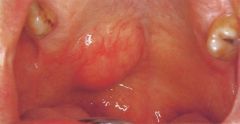
|
Pleomorphic Adenoma (Parotid 69%, Asymptomatic swelling) |
|
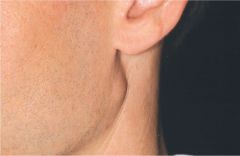
|
Pleomorphic Adenoma (Parotid 69%, Asymptomatic swelling)
|
|
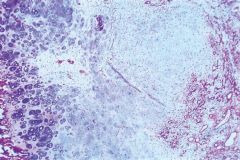
|
Pleomorphic Adenoma (multiple cells, chondroid, myxoid) |
|
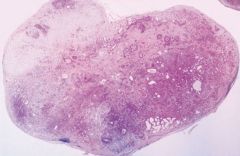
|
Pleomorphic Adenoma (multiple cells, chondroid, myxoid) |
|
|
Pleomorphic Adenoma treatment |
Surgical excision Has potential to become malignant in 5%
|
|
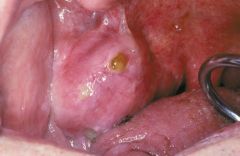
|
Pleomorphic Adenoma |
|
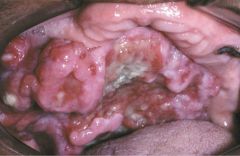
|
Malignant Mixed Tumor (60-70 yo
|
|
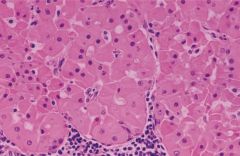
Overabundance of mitochondria = granularit
|
Oncocytoma (Parotid 78% Older adults 50-70yo
|
|
|
older smoking MALES
M>>>F 10:1 |
Papillary Cystadenoma Lymphomatosum (Warthin Tumor) |
|
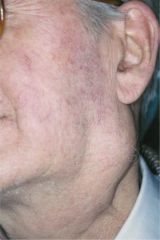
|
Papillary Cystadenoma Lymphomatosum (Warthin Tumor) - bilateral |
|

|
Papillary Cystadenoma Lymphomatosum (Warthin Tumor)
Double row of oncocytes in Lymphoid stroma
|
|
|
Upper lip Older Female
|
Monomorphic Adenoma (Canalicular adenoma
|
|
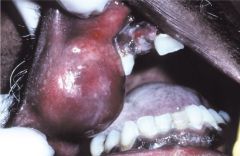
Minor salivary gland |
Canalicular Adenoma (upper lip older females) |
|
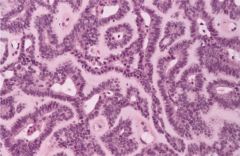
Minor salivary gland |
Canalicular Adenoma (upper lip older females) |
|

Parotid older female |
Basal Cell Adenoma |
|
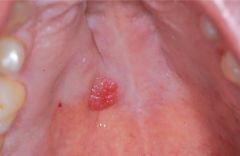
No association with HP
|
Ductal Papillomas Sialadenoma papilliferum |
|
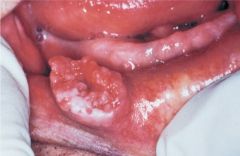
|
Inverted Ductal papilloma |
|
|
Only in the minor SG
|
Inverted Ductal papilloma |
|
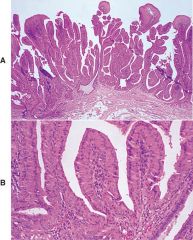
Ductal epithelium line the projection
|
Sialadenoma papilliferum |
|
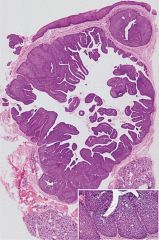
Papillary intraductal proliferation located beneath the mucosal surface |
Inverted Ductal papilloma |
|
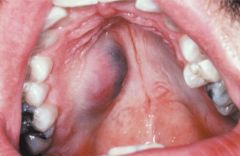
|
Mucoepidermoid Carcinoma |
|
|
most common Salivary Gland maligancy in children parotid 48% |
Mucoepidermoid Carcinoma |
|
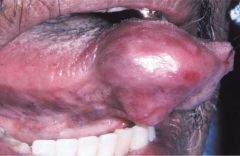
|
Mucoepidermoid Carcinoma |
|
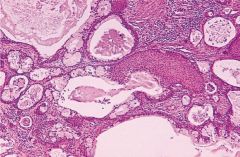
Ductal and cystic spaces surrounded by mucous & squamous cell
|
Mucoepidermoid Carcinoma |
|
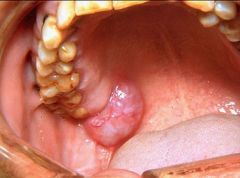
|
Mucoepidermoid Carcinoma |
|
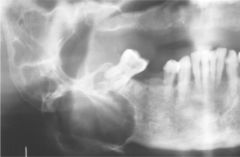
Most common and best-recognized intra-bony salivary tumor
|
Intraosseous Mucoepidermoid Carcinoma |
|
|
50% to 60% develop within the minor SG Slow growing PAINFUL mass Middle Aged
|
Adenoid Cystic Ca |
|
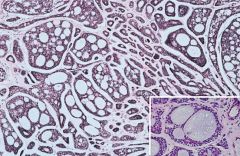
Swiss cheese” appearance +Neural Invasion
|
Adenoid Cystic Ca |
|
|
Adenoid Cystic Ca treatment |
excision radiation recurrence is high |
|
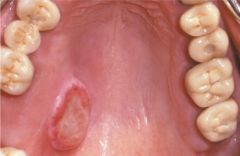
|
Polymorphous Low Grade Adenocarcinoma PLGA |
|
|
Minor SG only Older adults Painless Can erode underlying bon
|
Polymorphous Low Grade Adenocarcinoma PLGA |
|
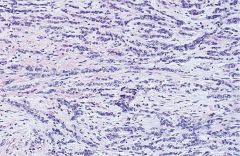
|
Polymorphous Low Grade Adenocarcinoma PLGA |
|
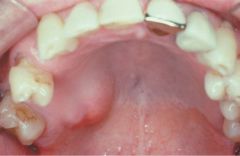
|
Polymorphous Low Grade Adenocarcinoma PLGA |
|
|
Stensen's duct |
Parotid Gland (watery secretion)
|
|
|
Wharton’s duct |
Submandibular Gland
|
|
|
Bartholin’s duct |
Sublingual Gland
|
|
|
Immune defense of saliva + digestion |
IgA Amylase |
|
|
Drug-induced hyposalivation |
Anti-cholinergics
|
|
|
Unstimulated saliva (which cells and glands) |
Basal production Mostly minor & submandibular outpu
|
|
|
Stimulated saliva (which gland) |
Mostly Parotid |
|
|
Salivary Gland Aplasia syndromes |
Treacher Collins Hemifacial Microsomia Syndrome
|
|
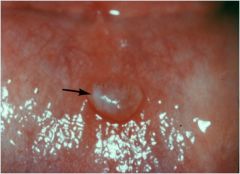
|
Mucocele (lower lip more often) |
|
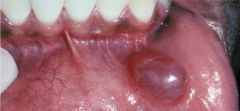
|
Mucocele (lower lip more often) |
|
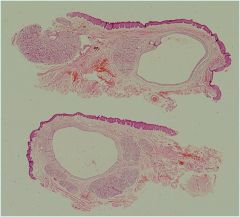
No epithelial lining Granulation tissue lines the central space
|
Mucocele (lower lip more often) |
|
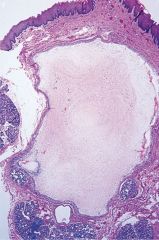
No epithelial lining Granulation tissue lines the central spac |
Mucocele (lower lip more often) |
|
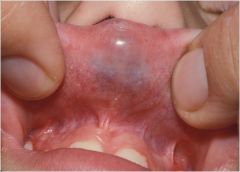
|
Mucoepidermoid Carcinoma |
|
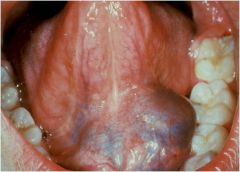
|
Ranula |
|
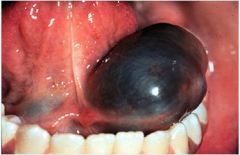
|
Ranula |
|
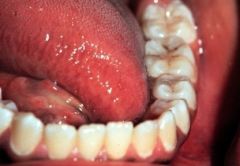
|
Ranula |
|
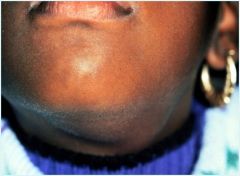
|
Ranula |
|

|
Ranula |
|
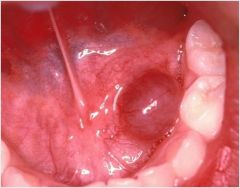
|
Ranula |
|
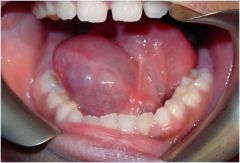
|
Ranula |
|
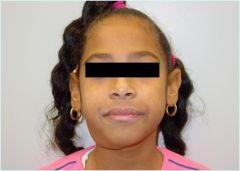
|
Ranula |
|
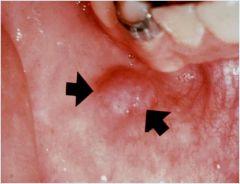
|
Mucus Retention Cyst (Salivary Duct cyst) |
|
|
Lining converts to squamous epithelium (true cyst) Looks like mucocele More likely in cystic fibrosis |
Mucus Retention Cyst |
|
|
Calcification Usually: submandibular gland duc
|
Sialolithiasis |
|
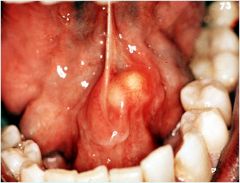
|
Sialolithiasis |
|
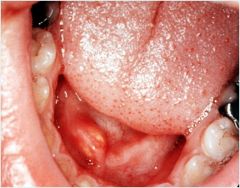
|
Sialolithiasis |
|
|
--Hyperparathyroidism -- Hypercalcemia
|
Sialolithiasis |
|
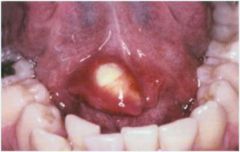
|
Sialolithiasis |
|
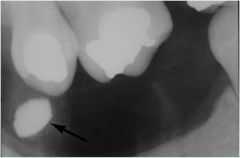
|
Sialolithiasis |
|
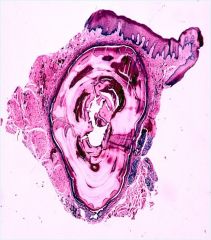
|
Sialolithiasis |
|
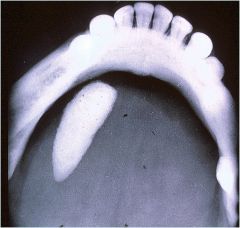
|
Sialolithiasis |
|
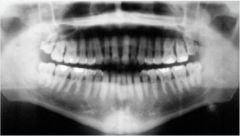
|
Sialolithiasis |
|
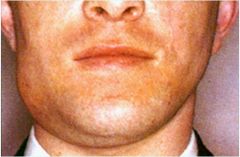
|
Sialadenitis |
|
|
Sialadenitis where first |
Infections of salivary glands
|
|
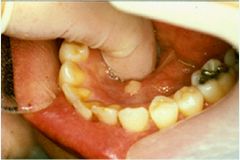
puss coming out |
Sialadenitis |
|

|
Sialadenitis |
|
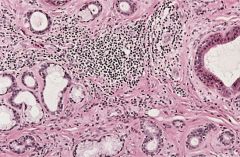
|
Sialadenitis |
|

|
Cheilitis Glandularis (minor salivary glands of lip) Increased SCCA lower lip most often |
|
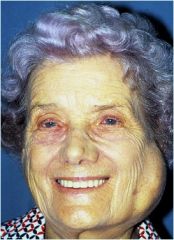
|
Sjögren's syndrome |
|
|
Immune attack against ductal cells Loss of tolerance in CD4+ T cells
|
Sjögren's syndrome |
|
|
Sjögren's syndrome 3 things |
Immune attack against ductal cells Loss of tolerance in CD4+ T cells |
|
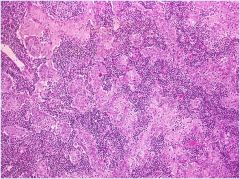
|
Sjögren's syndrome |
|
|
Sjögren's syndrome |
Sicca syndrome (dry eyes) (dry mouth) – RA (rheumatoid arthritis) – SLE (systemic lupus erythematosus) |
|
|
40x increased risk of non-Hodgkin B cell lymphoma |
Sjögren's syndrome |
|
|
Lymphoepithelial Lesion |
HIV + Sjögren's syndrome |
|
|
salivary gland enlargement, non-inflamatory |
Sialadenosis |
|
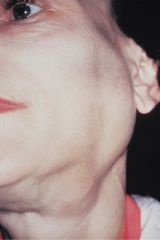
bilateral or unilateral |
Sialadenosis |
|
|
Sialadenosis (conditions associated) |
ENDOCRINE DISORDERS Nutritional Drugs
|
|
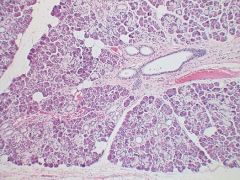
rare lesion of minor salivary glands |
Adenamatoid Hyperplasia |
|
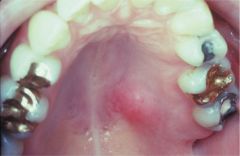
locally destructive inflammatory condition |
Necrotizing Sialametaplasia |
|
|
dental injection |
Necrotizing Sialametaplasia |
|
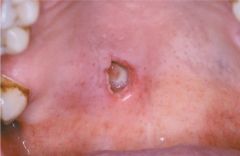
|
Necrotizing Sialametaplasia |
|
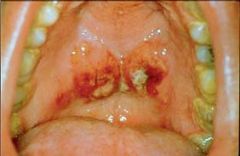
|
Necrotizing Sialametaplasia |
|
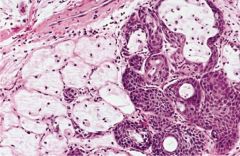
Acinar necrosis |
Necrotizing Sialametaplasia |
|
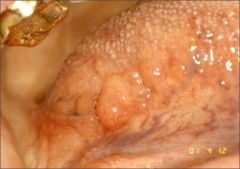
|
Lymphoid Hyperplasia (Cervical Lymphadenitis) |
|
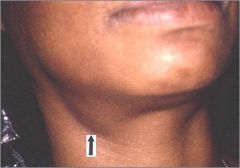
|
Lymphoid Hyperplasia (Cervical Lymphadenitis) |
|

|
Lymphoid Hyperplasia (Cervical Lymphadenitis) |
|
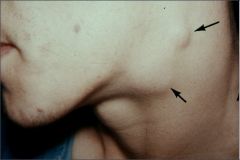
movable |
Lymphadenopathy infectious mononucleosis |
|
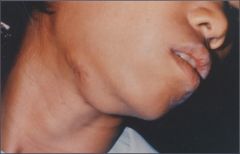
draining |
Lymphadenopathy tuberculosis |
|
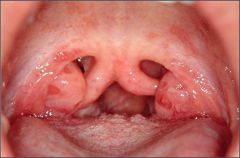
|
Tonsillitis |
|
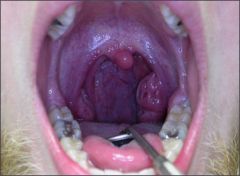
|
Tonsillitis |
|
|
Tingible bodies |
Tonsillitis |
|
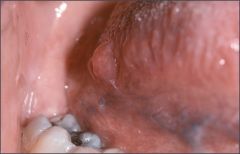
|
Hyperplastic Lingual Tonsil |
|
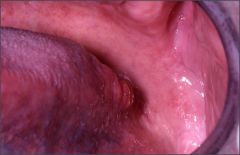
|
Hyperplastic Lingual Tonsil |
|

|
Hyperplastic Lingual Tonsil |
|
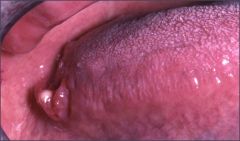
keratin plugs |
Lymphoid hyperplasia
differen: (Tonsillolithiasis Actinomycosis - bacterial Lymphoepithelial cyst) |
|
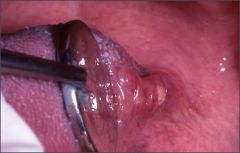
Tonsillolithiasis
|
Lymphoid hyperplasia
differen: (Actinomycosis - bacterial Lymphoepithelial cyst keratin plugs) |
|
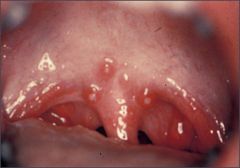
teenagers and young adults
|
lymphonodular Pharyngitis |
|
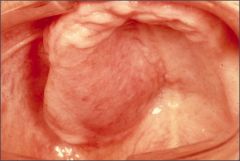
Diffuse, apparently benign proliferation of lymphoid cells
|
Benign Lymphoid Hyperplasia (Antibiotic therapy) |
|
|
Hemophilia A |
classic clotting factor 8 x linked recessive |
|
|
Hemophilia B |
clotting factor 9 Christmas disease x linked recessive |
|
|
Von Willebrands hemaphilia |
Plasma glycoprotein that binds to VIII and aids in adhesion of platelet Autosomal dominant
|
|
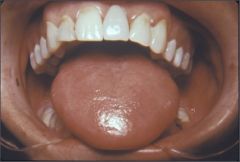
|
Pernicious Anemia (iron deficiency) |
|
|
Anemias |
-Iron deficiency anemia -Pernicious anemia (Hypovitaminosis B12) -Folic acid anemia -Hemolytic anemia
Females >>> males
|
|
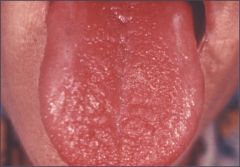
|
Anemia |
|
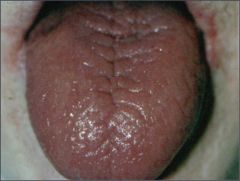
|
Anemia |
|
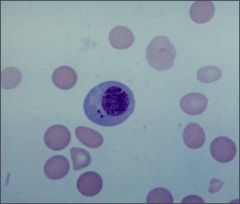
Howell-Jolly Bodies |
Anemia |
|
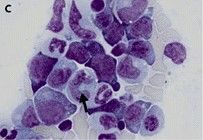
Horse shoe cell in bone marrow |
Anemia |
|
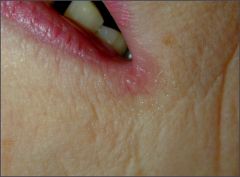
Burning Tongue Syndrome |
Early Symptom of Vitamin B Deficiency |
|
|
shovel shape fingernails (koilonychia) Atrophic Glossitis |
Iron Deficiency Anemia (no epi in these patients) |
|
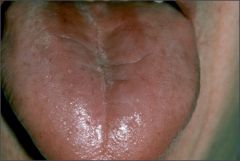
|
Plummer-Vinson Disease (Chronic, Severe Iron Deficiency ) |
|
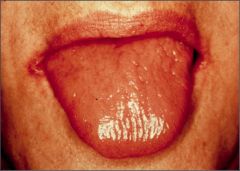
|
Plummer-Vinson Disease (Chronic, Severe Iron Deficiency ) |
|
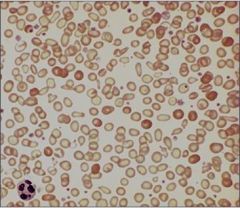
|
Plummer-Vinson Disease (Chronic, Severe Iron Deficiency ) |
|
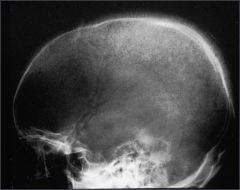
Blacks & Asians stepladder trabecular pattern hair on end skull |
Sickle Cell Anemia |
|
|
Hematopoietic Precursor Cells diminished in bone marrow |
Aplastic Anemia (Neutropenia
|
|
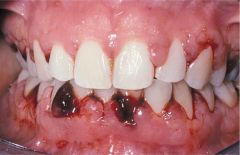
oral ulcers susceptible to infections |
Aplastic Anemia |
|
|
Decrease in the number of the circulating neutrophils below 1500/mm3 in an adult
|
Neutropenia |
|
|
Uniformed spaced episodes of neutrophil deficiency Severe periodontal bone loss (premature)
|
Cyclic Neutropenia |
|
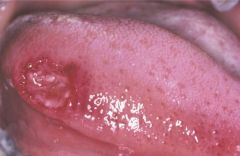
|
Cyclic Neutropenia |
|
|
Defective gene for beta or alpha Hgb
|
Thalassemia |
|
|
Beta-thalassemia |
(2 genes involved): Thalassemia minor - one bad gene Thalassemia major - both genes are bad |
|
|
Alpha-thalassemia |
(4 genes involved):
|
|
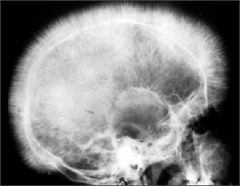
Hair-on-end skull radiograph |
Thalassemia |
|
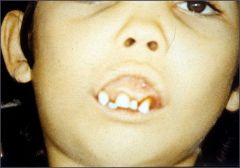
Frontal bossing
Bone marrow hyperplasia =
|
Thalassemia |
|

increased brusing Petechiae and ecchymosis Fibrin deposits |
Thrombocytopenia (Decreased number of platelet) |
|
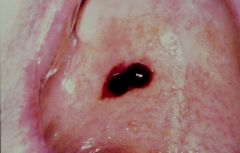
increased brusing Petechiae and ecchymosis Fibrin deposits |
Thrombocytopenia (Decreased number of platelet) |
|
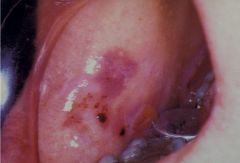
|
Thrombocytopenia with AIDS |
|
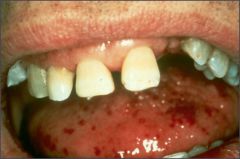
diascopy positive (blanching) |
Hereditary Hemorrhagic Telangiectasia |
|
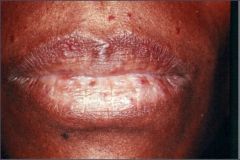
diascopy positive (blanching) |
Hereditary Hemorrhagic Telangiectasia |
|
|
Hereditary Hemorrhagic Telangiectasia which genes? AD? HHT1-2. |
HHT1: endoglin gene mutation
AD
|
|
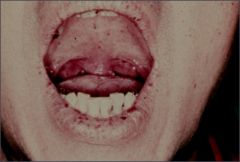
|
Hereditary Hemorrhagic Telangiectasia |
|
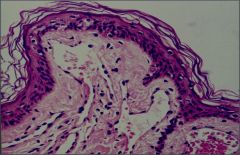
Dilated capillaries beneath epithelium
|
Hereditary Hemorrhagic Telangiectasia |
|
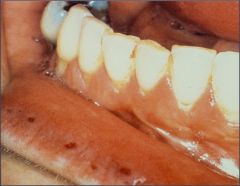
|
Hereditary Hemorrhagic Telangiectasia |
|
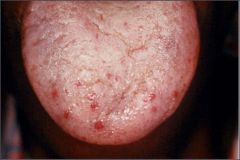
|
Hereditary Hemorrhagic Telangiectasia |
|
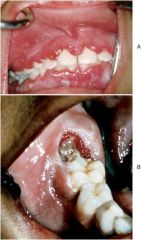
|
Leukemia |
|
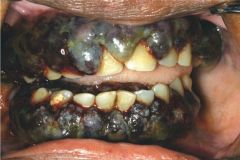
|
Leukemia |
|
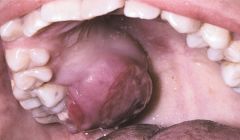
|
Leukemia |
|
|
Leukemia in adluts in children |
adults CML older adults CLL - most common children ALL all ages AML |
|
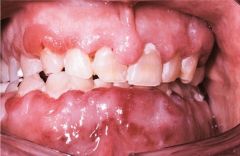
|
Leukemia |
|
|
Leukemia treatment |
Bone marrow biopsy Treatment = Chemo CLL - incurable |
|
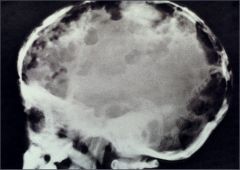
|
Langerhans Cell Histiocytosis (first 2 decades of life, Posterior mandible ) |
|
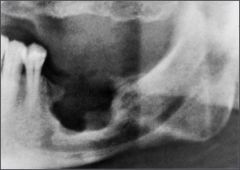
|
Langerhans Cell Histiocytosis |
|
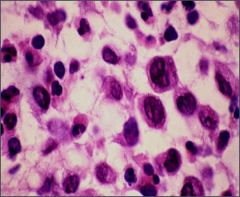
Proliferation of Langerhans cells
coffee bean shape |
Langerhans Cell Histiocytosis |
|
|
Acute disseminated histiocytosis
|
Letterer-Siwe disease |
|
|
Chronic disseminated histiocytosis
|
Hand-Schüller-Christian disease |
|
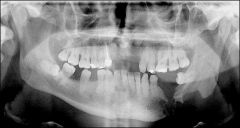
bone and tooth loss that does not make sense |
Langerhans Cell Histiocytosis |
|
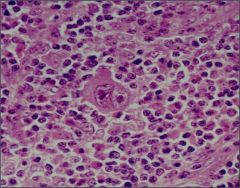
|
Hodgkin's Lymphoma (Malignancy of B-cells) (Cervical & supraclavicular lymph nodes
|
|
|
Unique tumor cell: Reed- -- A macrophage-like B-cell Binucleated :“owl eyes” |
Hodgkin's Lymphoma (Malignancy of B-cells) (Cervical & supraclavicular lymph nodes
|
|
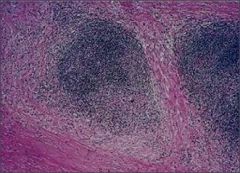
|
Hodgkin Disease nodular sclerosing (70%) MOST COMMON |
|
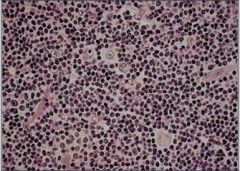
|
Hodgkin Disease Lymphocyte rich |
|

|
Non-Hodgkin's Lymphoma |
|
|
Non-Hodgkin's Lymphoma |
85% B-cell type Most common form of lymphoma |
|
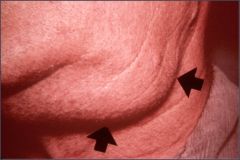
|
Non-Hodgkin's Lymphoma |
|
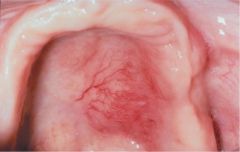
|
Non-Hodgkin's Lymphoma |
|
|
Helicobacter pylori infection Epstein-Barr virus (EBV) Bloom syndrome
|
Non-Hodgkin's Lymphoma |
|
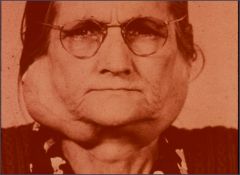
|
Non-Hodgkin's Lymphoma Mikulicz syndrome = lymphoma of |
|
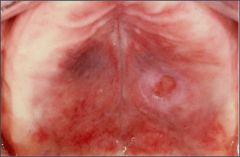
|
MALT lymphoma Non-Hodgkin's Lymphoma |
|

|
MALT lymphoma Non-Hodgkin's Lymphoma |
|
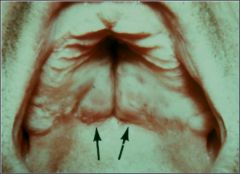
|
MALT lymphoma Non-Hodgkin's Lymphoma |
|
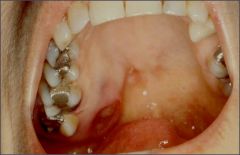
|
MALT Lymphoma MALT = mucosa associated lymphoid tissue |
|
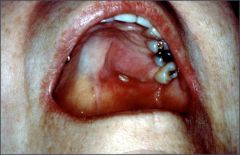
|
MALT Lymphoma MALT = mucosa associated lymphoid tissue |
|
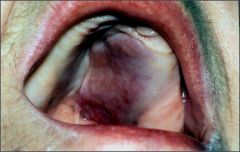
|
MALT Lymphoma MALT = mucosa associated lymphoid tissue |
|

|
MALT Lymphoma MALT = mucosa associated lymphoid tissue |
|
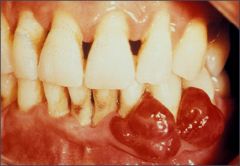
|
Non-Hodgkin Lymphoma (Mandible >>> maxilla) |
|
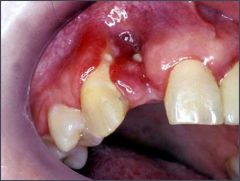
|
Non-Hodgkin Lymphoma (Mandible >>> maxilla) |
|
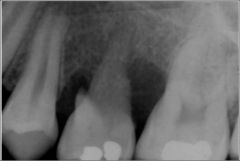
|
Non-Hodgkin Lymphoma (Mandible >>> maxilla) |
|

penny on the plate |
Non-Hodgkin Lymphoma (need immunohistochemistry) |
|

Epstein-Barr virus in 90% of tumors |
Burkitt Lymphoma Maligna cy of B-Lymphocytes; Undifferentiated Lymphoma |
|
|
Epstein-Barr virus in 90% of tumors Male >>females Posterior jaws
|
Burkitt Lymphoma |
|
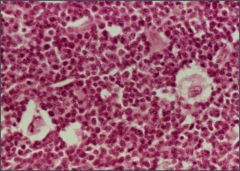
Starry-sky appearance |
Burkitt Lymphoma |
|

|
Burkitt Lymphoma |
|
|
Proliferation of malignant T-cells |
Angiocentric T-Cell Lymphoma "midline lethal granuloma" |
|
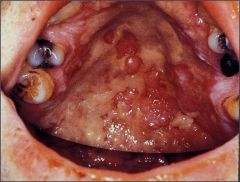
necrotic
|
Angiocentric T-Cell Lymphoma |
|
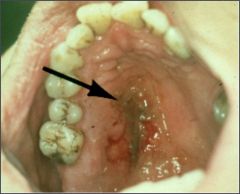
"midline lethal granuloma" |
Angiocentric T-Cell Lymphoma
|
|
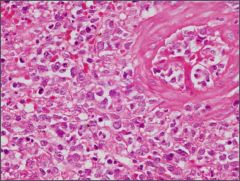
need immunohistochemistry |
Angiocentric T-Cell Lymphoma |
|

CD4+ T-helper cells origin |
Mycosis Fungoides Cutaneous T-Cell Lymphoma Males >>> females
|
|
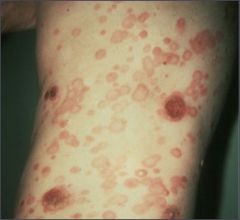
Epidermotropism
CD4+ T-helper cells origin |
Mycosis Fungoides Cutaneous T-Cell Lymphoma Males >>> females
|
|
|
Most common cutaneous lymphoma
|
Mycosis Fungoides |
|
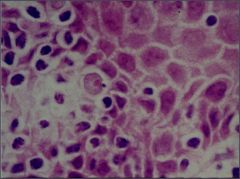
|
Mycosis Fungoides |
|
|
Mycosis Fungoides treatment |
no true cure Topical nitrogen mustard photochemotherapy
|
|
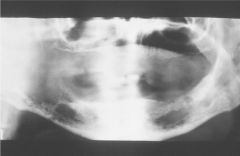
|
Multiple Myeloma |
|
|
60-70 yrs Multiple well defined RL Bence jones protein
|
Multiple Myeloma |
|
|
Sheets of malignant plasma cells with eccentric nuclei and stippled nuclear chromatin.
|
Plasmacytoma |
|

Hunter syndrome exhibits the characteristic facial features of this disorder
|
Muccopolysaccharidosis
|
|
|
Muccopolysaccharidosis |
-accumulation of glucosaminoglycans (impacted teeth) -macroglossia -thin enamel -gingival hyperplasia |
|

Gaucher disease |
Lipid Reticuloendotheliosis (Results in an accumulation of the lipids within a variety of cells) |
|
|
Gaucher disease Ashkenazi Jewish heritage
|
Lipid Reticuloendotheliosis (Results in an accumulation of the lipids within a variety of cells) |
|
|
Lack glucocerebrosidase Accumulation of glucosylceramide in lysosomes Bone pain accumulate glucosylceramide most common Lipid Reticuloendotheliosis |
Gaucher disease |
|
|
Deficiency of acid sphingomyelinase death early accumulate sphyngomyelin
|
Neimann-Pick Disease
|
|
|
Lack of b-hexosaminidase A die in 3-5 years accumulation of ganglioside |
Tay-Sachs disease |
|
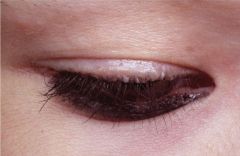
Thickened papules are present along margin of the eyelid
|
Lipoid Proteinosis |
|
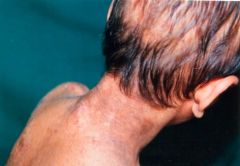
Deposition of waxy material in dermis and submucosal CT
|
Lipoid Proteinosis |
|
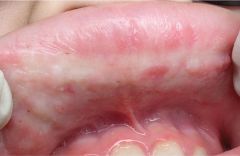
mucosa nodular, diffusely enlarged & thickened |
Lipoid Proteinosis |
|

lamellar |
Lipoid Proteinosis |
|
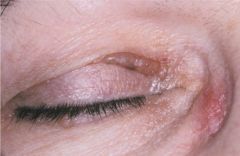
extracellular proteinaceous substance called amyloid
|
Amyloidosis |
|
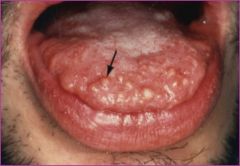
macroglossia |
Amyloidosis
(deposition of amyloid protein) |
|
|
Vitamin A Deficiency |
maintenance of vision growth and tissue differentiation |
|
|
Vitamin B-Thiamin Deficiency (B1) |
Beriberi functioning of neurons |
|
|
Vitamin B-Riboflavin Deficiency |
oxidation-reduction reactions
|
|
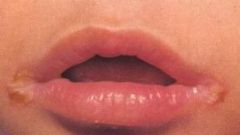
|
Vitamin B-Riboflavin Deficiency |
|
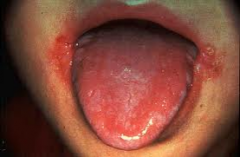
|
Vitamin B-Riboflavin Deficiency |
|
|
Vitamin B-Niacin deficiency (B3) |
Pellagra = rough skin Triad of dermatitis, dementia, and diarrhea
stomatitis and glossitis, with the tongue appearing red, smooth, and raw
|
|
|
Vitamin B-Pyridoxine Deficiency (B6) |
amino acid synthesis healthy brain function Signs = weakness, dizziness, seizure
|
|
|
Vitamin C Deficiency |
scurvy Ascorbic acid is necessary for the proper synthesis of collagen
gingival swelling with sponataneous hemorrhage, ulceration, tooth mobility, severe perio
|
|
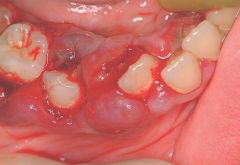
|
Vitamin C Deficiency |
|

|
Vitamin C Deficiency |
|
|
Vitamin D Deficiency |
Rickets= infancy
|
|
|
Vitamin E Deficiency |
A-tocopherol is a fat-soluble vitamin Liver disease antioxidant |
|
|
Vitamin K Deficiency |
Clotting factor Coagulopathy Oral = increased gingival bleeding
Wide variety of green vegetables |
|
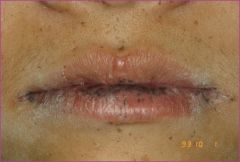
|
Peutz-Jehger's Syndrome |
|
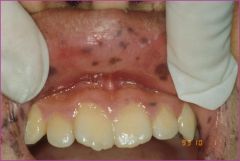
|
Peutz-Jeghers Syndrome |
|
|
Peutz-Jeghers Syndrome |
LKB1 gene
|
|
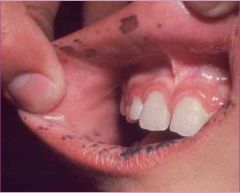
|
Peutz-Jeghers Syndrome |
|
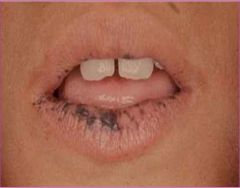
|
Peutz-Jeghers Syndrome |
|
|
Polyposis |
Peutz-Jeghers Syndrome |
|
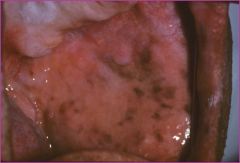
|
Addison’s (more wide) |
|
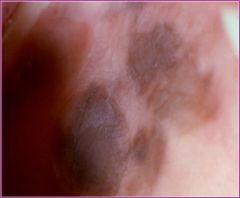
|
Addison’s (more wide) |
|
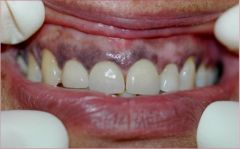
|
Tetracycline pigmentation |
|
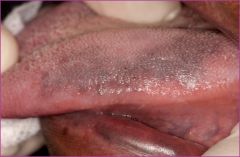
|
Tetracycline pigmentation |
|

hypocalcification of the skeletal structures
|
hypophosphatasia (Deficiency of tissue-nonspecific alkaline phosphatase)
|
|
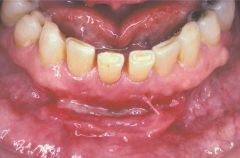
very linear ulcerations of the mandibular vestibule |
Crohn’s Disease |
|
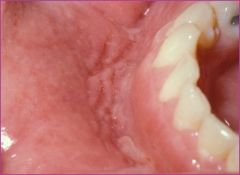
|
Crohn’s Disease (very linear ulcerations of the mandibular vestibule) |
|
|
Cobblestone appearance of the mucosa, and deep granulomatous-appearing ulcers
|
Crohn’s Disease |
|
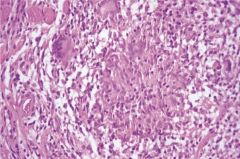
Nonnecrotizing granulomatous inflammation of submucosal CT
|
Crohn’s Disease |
|
|
Crohn’s Disease treatment |
-Sulfa type of drug (sulfasalazine)
|
|

snailtrack |
Pyostomatitis Vegetans (Crohn’s & Ulcerative colitis) |
|
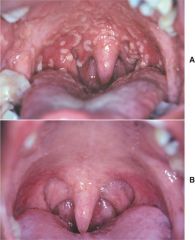
|
Pyostomatitis Vegetans (snailtrack) |
|

before and after dialysis |
Uremic Stomatitis |
|

|
Uremic Stomatitis |
|
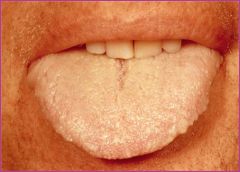
|
Uremic Stomatitis |
|
|
no eye lashes no eye brows no sweat glands Males >>>>> females can not regulate temperature |
Ectodermal Dysplasia |
|
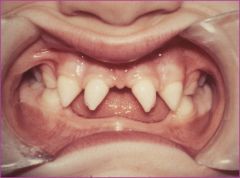
|
Ectodermal Dysplasia |
|

|
Ectodermal Dysplasia |
|
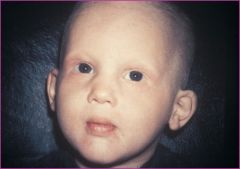
|
Ectodermal Dysplasia |
|
|
Ectodermal Dysplasia oral presentation |
Oligodontia -- Diminished number of teeth |
|
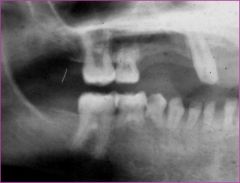
|
Ectodermal Dysplasia |
|
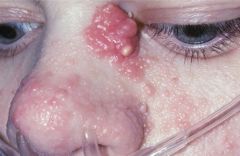
|
Tuberous Sclerosis |
|
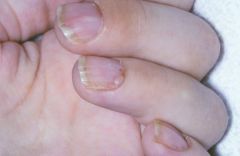
Ungual or periungual fibromas |
Tuberous Sclerosis |
|
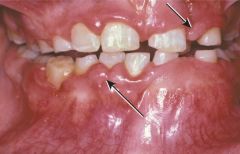
|
Tuberous Sclerosis |
|
|
shagreen patches Cardiac rhabdomyoma Disruption of the tumor suppressor activit hypopigmentation called ash-leaf spot
|
Tuberous Sclerosis |
|
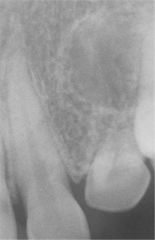
Multiple, randomly distributed enamel pits
|
Tuberous Sclerosis |
|
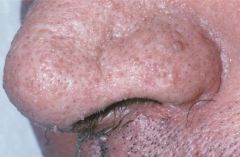
|
Multiple Hamartoma Syndrome Cowden’s Syndrome |
|
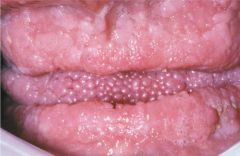
Multiple, irregular fibroepithelial papules involve the tongue and alveolar ridge mucos
|
Multiple Hamartoma Syndrome Cowden’s Syndrome |
|
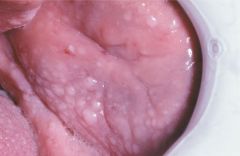
|
Cowden’s Syndrome |
|
|
-Most common Lipid Reticuloendotheliosis -Lack glucocerebrosidase -Accumulation of glucosylceramide |
Gaucher Disease |
|
|
-type of Lipid Reticuloendotheliosis -Deficiency of acid sphingomyelinase -Accumulation of sphyngomyelin |
Neimann-Pick Disease |
|
|
-type of Lipid Reticuloendotheliosis -Lack of b-hexosaminidase A
|
Tay-Sachs Disease |
|
|
What is the second most common cyst, is derived from degenerated stellate reticulum? |
Dentigerous cyst |
|
|
Which lesion is associated with rosette structures (zellballen), hamartomas, young females, is located in the anterior maxilla, and is derived from reduced enamel epithelium? |
Adenamatoid Odontogenic Tumor (AOT) |
|
|
Which lesion has a ground glass appearance and a mutation in GNAS 1 gene? |
Fibrous Displasia of the bone
|
|
|
Which lesions are multilocular and have scalloped borders in the radiolucency? |
Central Giant Cell Granuloma and traumatic bone cyst |
|
|
Which lesion derives from malignant neoplasm of neuroectodermal cells, is associated with young white males, and has moth eaten borders? |
Ewing sarcoma |
|
|
Which lesion resembles a Cementoblastoma but is not attached to the root?
|
Osteoblastoma |
|
|
Which lesion is very painful but relieved with aspirin? |
Osteoid Osteoma |
|
|
Which lesion is not relieved by aspirin? |
Osteoblastoma |
|
|
Which lesion looks similar to mandibular tori? |
Osteoma |
|
|
Starry sky appearance |
Burkitts lymphoma
|
|
|
Eosinophilic Ghost Cells are characteristic of what kind of cyst? |
Calcifying Odont Cyst |
|
|
Mutation of PATCH gene is assoc with what syndrome? |
Gorlin Syndrome |
|
|
Reed-Sternberg Cells can be found in what kind of lymphoma? |
Hodgkin Lymphoma |
|
|
Most common inherited disorder |
Thalassemia |
|
|
hair on end skull (2 diseases) |
Thalassemia Sickle cell anemia |

